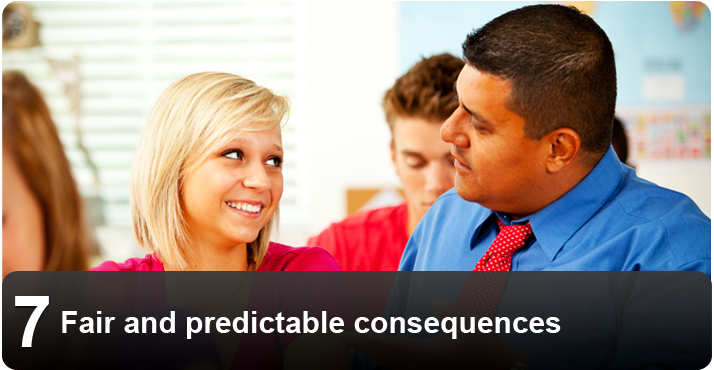“The best discipline plans strive to limit the need for punishments
and negative consequences by having a preventive emphasis.”
– Mark Boynton and Christine Boynton, The Educator’s Guide
to Preventing and Solving Discipline Problems
Negative consequences are necessary when other approaches to problem behaviour
are unsuccessful. However, they are not effective when overused.
Establish consequences to inappropriate behaviours ahead of time; for example:
- owing time at recess, lunch or after school to make up for time lost in
class
- loss of free choice or other classroom privileges
- moving the student’s desk away from peers.
The most effective consequences are:
- immediate (but not disruptive or intensive)
- reasonable (and not embarrassing or frustrating)
- well-planned (but flexible)
- practical and easy to implement.
Since the goal is to reduce the incidence of a specific problem behaviour,
teachers have to monitor the effectiveness of negative consequences, and adapt
and change them as needed.
Focus on the behaviour
Disapprove of the behaviour, not the student. Use words and/or actions that
focus on the problem behaviour. This approach tells the student that the adult
believes he or she is capable of behaving in positive ways. It also reduces
power struggles that can create a negative atmosphere in the classroom.
Begin with low-key responses
Feedback
Both verbal and nonverbal feedback are effective responses to problem behaviour.
For example, say the student’s name out loud with an accompanying gesture
such as fingers over lips. Or use just one or two words such as, “Jordan,
chair” when a student is rocking back on two chair legs.
Actions, not words
When possible, use actions rather than words. For example, if two students
are whispering during a lesson, stop talking and wait patiently for them to
stop. Then continue the lesson without a reprimand. If a student is bouncing
a ball in the gym while instructions are being given, simply walk over and
collect the ball until the instructions are finished. Return the ball when
the activity starts. Talking less and acting more can often bring about positive
classroom change without paying an excessive amount of attention to problem
behaviour. Taking action also communicates that learning and teaching are important
and need to be the focus.
Proximity
Send a quiet and effective message about behavioural expectations by moving
around the classroom while teaching and stopping for a moment near specific
students. Standing near a student who is engaged in disruptive and/or attention-seeking
behaviour is often enough to end the behaviour. This technique communicates,
even without eye contact, that the teacher knows what is happening in the classroom
and expects positive behaviour.
Hurdle helping
Offer encouragement, support and assistance to prevent students from becoming
frustrated with learning activities. This kind of help can take many forms,
from enlisting a peer for support to supplying additional information and hints
that will help the student complete the learning task successfully.
Eye contact
Eye contact lets students know the teacher is aware of what they are doing.
Eye contact with a smile that says “thank you” will often stop
problem behaviour and allow learning to continue without disruption.
Students’ names
Using students’ names intentionally and positively lets them know they
are not anonymous. (This is particularly important at the secondary level.)
To deal with low-level problem behaviour, try including a student’s
name with the information or instructions being delivered. This technique gets
the student’s attention and lets him or her know that the teacher has
noticed the behaviour.
Be aware that a name can be spoken in any number of ways, with different intonations
that communicate different messages.
Gestures
Simple hand or face movements can communicate a message. For example, a nod
of the head means “yes,” and a smile can communicate “thank
you.” A teacher of younger students might hold up four fingers to tell
a student to keep four chair legs on the floor.
A brief touch on a student’s desk or chair is a low-key way of communicating
about the need to stop inappropriate behaviour. It is not always necessary
to make eye contact, and the touch can be light and quick enough that other
students are not likely to notice it.
Gestures can be effectively combined with proximity, eye contact and using
the student’s name.
Redirecting
Sometimes simply redirecting a student from one area or activity to another
area or activity will stop a problem behaviour. Redirecting can be done to:
- create a diversion (e.g., “Time for a break, go and get a drink of
water”)
- introduce a more appropriate replacement behaviour (e.g., “Please
take your library book to the reading corner. You can talk with your friend
about it there”)
- remove the context that is triggering a problem behaviour (e.g., “Time
to put away the math blocks”).
Pausing and waiting
A pause can effectively draw students’ attention back to the task at
hand. If after four or five seconds the pause has not helped the students refocus,
try other strategies.
Planned ignoring
Ignoring students who engage in attention-seeking behaviour but are not interfering
with teaching or learning usually causes the behaviour to stop. Carry on as
if nothing has happened and avoid any indication of annoyance or frustration,
which would give the student the attention he or she is seeking.
Planned ignoring behaviour is challenging, as the inappropriate behaviour
often increases before it decreases. Methods of planned ignoring include breaking
eye contact, moving to another area of the classroom and engaging in another
activity. Use this strategy for minor inappropriate behaviours that do not
compromise the safety or well-being of others.
In some cases, it may be necessary to coach other students on how to support
this strategy by either removing themselves as an audience or following the
teacher’s cue to ignore a certain behaviour.



